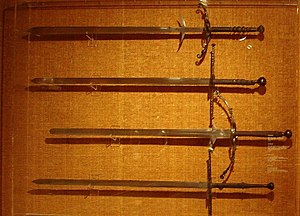Zweihänder
| Zweihänder | |
|---|---|

Zweihänders with and without Parierhaken
|
|
| Type | Sword |
| Service history | |
| In service | ca. 1500-1550 |
| Specifications | |
| Weight | 2–3.2 kilograms (4.4–7.1 lb) |
| Length | up to 180 centimetres (5.9 ft) |
|
|
|
| Blade type | Double-edged, straight bladed |
| Hilt type | Two-handed cruciform, with pommel |
The Zweihänder (German pronunciation: [t͡svaɪhɛndɐ]) (German "two hander") also Doppelhänder ("double-hander") or Beidhänder ("both-hander") is a large two-handed sword primarily in use during the early decades of the 16th century.
The Zweihänder swords developed from the bastard sword or montante of the Late Middle Ages and they became a hallmark weapon of the German Landsknechte from the time of Maximilian I (d. 1519) and during the Italian Wars of 1494–1559. The Goliath Fechtbuch (1510) shows an intermediate form between longsword and Zweihänder.
These swords represent the final stage in the trend of increasing size that started in the 14th century. In its developed form, the Zweihänder has acquired the characteristics of a polearm rather than a sword. Consequently, it is not carried in a sheath but across the shoulder like a halberd.
By the second half of the 16th century, these swords had largely ceased to have a practical application, but they continued to see ceremonial or representative use well into the 17th century. Some ceremonial zweihänder, called "bearing-swords" or "parade-swords" (Paradeschwert) were much larger and weighed about 10 pounds (4.5 kg).
Due to their size and weight—typically at least 1.4 m (4 ft 7 1⁄8 in) long and with a weight of over 2 kg—Zweihänders require two hands, as such they require at least 25 cm (9.84 in) for the grip. Zweihänders above 4 kg were confined to ceremonial use.
Early Zweihänders were simply larger versions of longswords. Later examples had Parierhaken ("parrying hooks") at the top of the ricasso as well as side rings on the hilt. A sword did not necessarily have both features. Some Zweihänders had wavy blades and were called Flammenschwert.
...
Wikipedia
